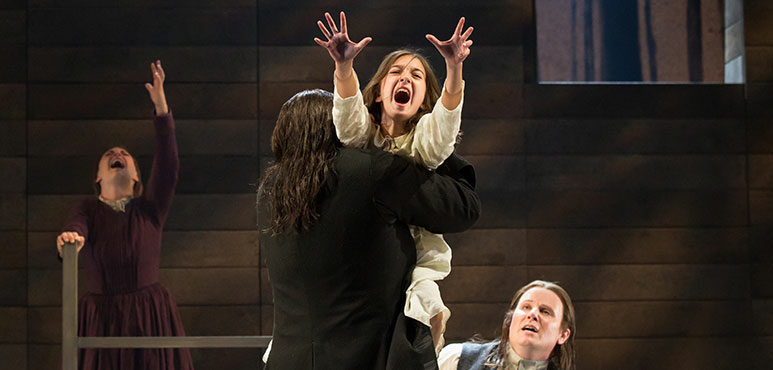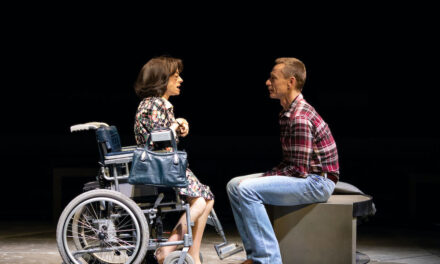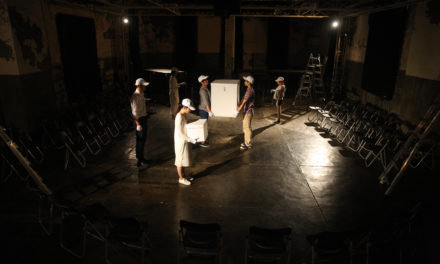Arthur Miller’s classic play about the 17th-century witchcraft trials in colonial Salem, Massachusetts has long been seen as a barely disguised parable of the contemporary hysteria surrounding the House Un-American Activities Committee.
It was an historical moment of post-war panic in which Communists were seen as infiltrating every corner of American society. Courtroom oaths of loyalty were weighed against denunciation, rumor, and false evidence in a Red Scare that famously destroyed the livelihood of artists and intellectuals, including whole swathes of the film industry who were blacklisted. But, as Miller reminds us, there was an earlier, even more, dangerous set of events which made him realize that the Puritan mass frenzy was not an anomaly in history. The poisonous flowers of Fascist and National Socialist ideology had found fertile soil in the mass hysteria of crowds led by charismatic leaders.
The Stratford production of Miller’s tragedy knits this high drama of contagion together with a moving personal story at its center. What results are not only scenes of sweeping, dynamic action, but also still moments of quiet emotion and pathos. The current production mines both of these registers of the play with unfailingly fine performances throughout, in a drama whose supporting cast is more than usually important in conveying the interlocked tensions of a whole community in crisis. What makes this production soar in the end, however, is the intensely imaginative and intelligent visual conception of the gnawing worm at the heart of Salem. The brilliantly achieved teamwork of director Jonathon Goad and designer Michael Gianfrancesco (with a nod to the lighting designer Bonnie Beecher) make this one of the most stunningly coherent visual productions of The Crucible that you will ever see.
The set is a minimalist affair, gesturing towards architecture that is both timeless and modern; its three openings seamlessly shifting to create doors and windows. In the tradition of the revolutionary English scenic designer Gordon Craig, modernist abstraction paradoxically creates a space for symbolic meanings. The faintly outlined trees of the first act gradually expand until they dominate the stage. Their growing presence underlines their role in a plot in which the whole action unspools from the forbidden dancing and tarrying with the supernatural of the young women in the forest, led by the scheming Abigail Williams (in a consistently strong and energetic performance by Katelyn McCulloch). But this dynamic between the rigid contours of the built set (its doors will later become prison windows) and the wild possibilities of the forest also condenses the central tension in the play.
For, while this Salem community is a Puritan theocracy whose norms and laws are mandated by God and biblical scripture, they are unleashed by mortal men and women motivated by all-too-human frailties of jealousy, greed, and rank resentment. In turn, their failure to acknowledge passions, both material and carnal, is figured in the spectral haunting of the forest as a return of the repressed. Theirs is a life-denying theology whose ethic is echoed by an equally drab aesthetic. The monochromatic colors that dominate the set and costumes suggest the muted earth colors and limited palette of Dutch genre painting (produced by a dour Protestant Calvinist society of the same century). The exception is the young women accused of witchcraft in the forest, who wear faint pastel costumes that provide a hint at their longing to escape the confinement of their proscribed roles, making them an easy target to be co-opted into Abigail’s own turbulent drama.
In this Puritan society, power is one central axis motivating the action, but sexual repression is another. The backstory of the play, from which the witchcraft plot springs like a steel trap, is the illicit affair between the upstanding but stubbornly individual John Proctor (with Tim Campbell delivering a powerful performance that grows in stature as he becomes increasingly ensnared in the accelerating denunciations) and Abigail, his households’ former employee. In her desire to destroy his loyal wife Elizabeth Procter (Shannon Taylor’s performance moves perceptively from puritanical coldness to self-understanding) and take her place in his bed, Abigail proves herself to be not only a cunning adversary but also possessing something of the power of the charismatic cult leader. Goad captures her mastery of the other young women in a powerfully distilled image, a mute pietà in which she enfolds her wayward charges, and they, her, like a perverse Madonna.
The initial crisis is the mysterious illness of little Betty Parris which her father Reverend Parris (in a finely modulated performance by Scott Wentworth) tries to understand against the backdrop of his own witnessing of the unseemly events in the forest. Reluctant to contaminate his family with any rumor of witchcraft, since his position in Salem is already precarious, he first questions his Barbadian slave, Tituba (whose hysteria adroitly captures her powerlessness in a white colonial society) and is then forced to call on the expertise of Reverend Hale. An idealistic intellectual who turns up with a stack of books on the dark arts, Hale (Ryan Wilkie) is an unwitting accomplice to the judicial savagery his witchcraft investigation is about to unleash. As the only character who actually undergoes a transformation in the play and demands a fair hearing for the accused, Wilkie delivers a nuanced and intelligent performance. Yet, the judicial day is won by two more severe and merciless interpreters of the law as practiced in this theocratic court. Roy Lewis is a forceful dramatic presence as Judge Hathorne, while in the central courtroom role of Deputy Governor Danforth, Wayne Best powerfully commands the stage.
As in the personages of classical tragedy from Aeschylus to Shakespeare, fate flows directly from character. But even virtue spells doom in a court which unwittingly values lies over truth by making false confession the only route to being absolved and demanding denunciation, even of the innocent. Procter refuses both moral compromises at first and, though he temporarily relents, he cannot bring himself to destroy others. What governs his decision, in the end, is his sense that his good name is the most valuable thing he possesses. A truer kind of confession follows in a scene of Shakespearean intensities between husband and wife in prison. Elizabeth blames her own coldness as a wife for his adultery, while a bent John Procter stands taller than ever in his abject brokenness.
This is ensemble acting at its best. The cast is uniformly fine throughout and together they conjure (theatre was once considered one of the devil’s arts) a world of man-made menace and weakness that is too often blamed on forces outside the often black human heart. Miller came quickly to understand that his drama of the post-war period was also a cautionary tale for all seasons. By the time that the film version of The Crucible appeared almost 50 years later (its star, Daniel Day-Lewis, would marry Miller’s daughter, Rebecca, after meeting on the set). Miller recalled how the play had “stumbled into history,” reverberating now in “furies of fanaticism and paranoia” played out on the national stages of Argentina, Chile, Greece, Czechoslovakia, China, and a dozen other countries.
In his memoir Timebends, Miller observed: I can almost tell what the political situation in a country is when the play is suddenly a hit there–it is either a warning of tyranny on the way or a reminder of tyranny just past.” Like Margaret Atwood’s dystopian The Handmaid’s Tale (undergoing a remarkable cultural moment in its Hulu television adaptation), with which it shares both a Puritan historical framework and penchant for parable, Stratford’s The Crucible would seem to confirm Miller’s uncanny insight.
Stratford Festival Theatre, Avon Theatre
This article was originally published on http://capitalcriticscircle.com/ on August 19, 2019. Reposted with permission. Read the original article.
This post was written by the author in their personal capacity.The opinions expressed in this article are the author’s own and do not reflect the view of The Theatre Times, their staff or collaborators.
This post was written by Barbara Gabriel.
The views expressed here belong to the author and do not necessarily reflect our views and opinions.


















